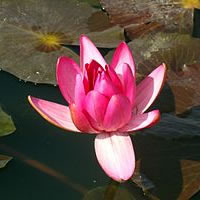
There was talk of ponds and water lilies last night at the French conversation group and I discovered that one French word for water lily is nymphéa [nɛ̃.fe.a], which comes from nymphaea the Latin name for this genus of plants. The Latin word comes from the Ancient Greek word νύμφη (nymphe), which means girl, and also refers to a low ranking female deity who haunts rivers, springs, forests and other places [source].
Nymphéa refers specifially to the white water lily, or nymphaea alba, which also known as the European White Waterlily, White Lotus, or Nenuphar, a name that is also found in French: nénuphar [ne.ny.faʁ], and which comes via the Persian نيلوفر (ninufar) or the Arabic نلوفر (nilufar), from the Sanskrit नीलोतपल (nīlotpala – blue lotus), from नील (nīla – blue-black) and उतपल (utpala – lotus) [source].
Many names for plants in French come directly from Latin, whereas in English many plants have common names and Latin names. In other languages do plants have both common and Latin-derived names, or just one or the other?
I had a kind of epiphany when I started gardening in France.The “language of flowers” was popular in the late 19th century, and in the twentieth too. I remember being given a little book about it when I was a girl. Anyway:
Flower Language: Pansy (Victorian): “to think,” particularly of love.
The French for pansy? “Pensee” or “thought”. If plant a pansy you are, linguistically, planting a thought.
Horoscope signs in English are in Latin. If you don’t know Latin you need a picture to know that “Libra” is “scales”. But Libra in French is “Balance” (scales). So in both cases no intermediary needed or possible in French.
I’ve found this particularity of French to be quite useful. The French version of Wikipedia is relatively sparsely populated with plants (compared to the English version) and it can be difficult to find information. I’ve found that I can often plug the French common name for a plant into the English Wikipedia and get a result for the genus, which usually has links to common varieties.
In Finnish we only use Finnish names, but that’s understandable because we haven’t been under that much influence from Latin or Romance languages. There’s a clear distinction between a plant’s (or animal’s) Finnish name and its scientific name (which I never call Latin, because that’s a totally different thing). I haven’t realized that the distinction is much less clear in English. You used the word “Latin-derived name” which indicates that you actually think of them as being English.
I hadn’t heard the word nenuphar before, but that rang a certain bell and I had to check where the generic name of yellow water-lilies (Nuphar) comes from. According to Wikipedia, it is a contraction of nenuphar. It’s hard to think of yellow water-lilies as blue lotuses.
Sanskrit has another word for the blue lotus, कमल (kamala). In Finnish, kamala means ‘terrible’.
The sacred lotus is called पद्म (padma).
janestheone: Finnish also has translated names for zodiac signs. Libra = Vaaka (scales).
In Welsh you tend to have the standard Welsh name ie. alaw (water water-lily) and then a normally long list of alternative Welsh names:
lili ddŵr wen
lili-ddŵr wen
alaw
ala y dŵr
alaw y llyn
bwltis
godywydd
lili gwyn y dŵr
y fagwyr wen
magwyr wen
alaw gwyn
So you can imagine how useful it is having the Linnaean binomial nomenclature system for the scientific Latin names:
Nymphaeaceae – teulu lili`r dŵr (water-lily family)
Nymphaea alba – alaw – white water-lily
Oops typo. (water water-lily) = (white water-lily)
Just a little correction: the Persian version is (as written in Arabic script) is “nilufar” and not “ninufar”. To be exact, I heard the name of this plant spelled in Arabic as: nay-lú-far, rather than ni-lo-far.
I didn’t know it is a water lily though and I thought it is a different kind of plants, which was famous in Andalusia back then in medieval times.
I remember one story (but I’m not sure how exact it is), which tells that the famous “caliph” of the Abbasid dynasty, Harun Al-Rasheed, did hate to see Nilufer plants in his palace because it always reminded him of Andalusia; a region that remained out of the reach of the Abbasids after the fall of the Umayyads, and remained loyal to the Umayyads back then (and developed its own Islamic heritage and culture eventually). They say Harun, like his predecessors, could not bring that region under his rule (I think majorly because of the geographical difficulties back then).